Ascending projections from the caudal visceral nucleus of the solitary tract to brain regions involved in food intake and energy expenditure
- PMID: 20353764
- PMCID: PMC2909454
- DOI: 10.1016/j.brainres.2010.03.059
Ascending projections from the caudal visceral nucleus of the solitary tract to brain regions involved in food intake and energy expenditure
Abstract
Metabolic homeostasis reflects the complex output of endocrine, autonomic, and behavioral control circuits that extend throughout the central nervous system. Brain regions that control food intake and energy expenditure are privy to continuous visceral sensory feedback signals that presumably modulate appetite, satiety, digestion, and metabolism. Sensory signals from the gastrointestinal tract and associated digestive viscera are delivered to the brain primarily by vagal afferents that terminate centrally within the caudal nucleus of the solitary tract (NST), with signals subsequently relayed to higher brain regions by parallel noradrenergic and peptidergic projection pathways arising within the NST. This article begins with an overview of these ascending pathways identified in adult rats using a standard anterograde tracer microinjected into the caudal visceral sensory region of the NST, and also by immunocytochemical localization of glucagon-like peptide-1. NST projection targets identified by these two approaches are compared to the distribution of neurons that become infected after inoculating the ventral stomach wall with a neurotropic virus that transneuronally infects synaptically-linked chains of neurons in the anterograde (i.e., ascending sensory) direction. Although the focus of this article is the anatomical organization of axonal projections from the caudal visceral NST to the hypothalamus and limbic forebrain, discussion is included regarding the hypothesized role of these projections in modulating behavioral arousal and coordinating endocrine and behavioral (i.e., hypophagic) responses to stress.
2010 Elsevier B.V. All rights reserved.
Figures
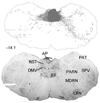
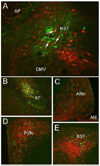
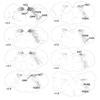
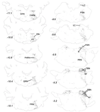

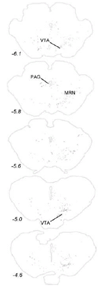
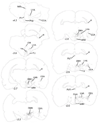


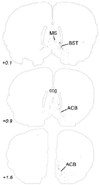
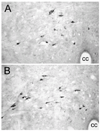
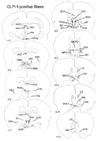

Similar articles
-
Differential activation of chemically identified neurons in the caudal nucleus of the solitary tract in non-entrained rats after intake of satiating vs. non-satiating meals.Physiol Behav. 2014 Sep;136:47-54. doi: 10.1016/j.physbeh.2014.01.015. Epub 2014 Feb 6. Physiol Behav. 2014. PMID: 24508750 Free PMC article.
-
The nucleus tractus solitarius: a portal for visceral afferent signal processing, energy status assessment and integration of their combined effects on food intake.Int J Obes (Lond). 2009 Apr;33 Suppl 1:S11-5. doi: 10.1038/ijo.2009.10. Int J Obes (Lond). 2009. PMID: 19363500 Review.
-
Synaptic Inputs to the Mouse Dorsal Vagal Complex and Its Resident Preproglucagon Neurons.J Neurosci. 2019 Dec 4;39(49):9767-9781. doi: 10.1523/JNEUROSCI.2145-19.2019. Epub 2019 Oct 30. J Neurosci. 2019. PMID: 31666353 Free PMC article.
-
Hindbrain noradrenergic lesions attenuate anorexia and alter central cFos expression in rats after gastric viscerosensory stimulation.J Neurosci. 2003 Nov 5;23(31):10084-92. doi: 10.1523/JNEUROSCI.23-31-10084.2003. J Neurosci. 2003. PMID: 14602823 Free PMC article.
-
Peptide signals regulating food intake and energy homeostasis.Can J Physiol Pharmacol. 2002 May;80(5):396-406. doi: 10.1139/y02-035. Can J Physiol Pharmacol. 2002. PMID: 12056545 Review.
Cited by
-
Peptide and lipid modulation of glutamatergic afferent synaptic transmission in the solitary tract nucleus.Front Neurosci. 2013 Jan 10;6:191. doi: 10.3389/fnins.2012.00191. eCollection 2012. Front Neurosci. 2013. PMID: 23335875 Free PMC article.
-
Dysfunctional nucleus tractus solitarius: its crucial role in promoting neuropathogenetic cascade of Alzheimer's dementia--a novel hypothesis.Neurochem Res. 2012 Apr;37(4):846-68. doi: 10.1007/s11064-011-0680-2. Epub 2012 Jan 5. Neurochem Res. 2012. PMID: 22219130 Review.
-
Age-associated gut microbiota impair hippocampus-dependent memory in a vagus-dependent manner.JCI Insight. 2022 Aug 8;7(15):e147700. doi: 10.1172/jci.insight.147700. JCI Insight. 2022. PMID: 35737457 Free PMC article.
-
Peripheral interleukin-2 level is associated with negative symptoms and cognitive performance in schizophrenia.Physiol Behav. 2014 Apr 22;129:194-8. doi: 10.1016/j.physbeh.2014.02.032. Epub 2014 Feb 25. Physiol Behav. 2014. PMID: 24576679
-
Glutamatergic phenotype of glucagon-like peptide 1 neurons in the caudal nucleus of the solitary tract in rats.Brain Struct Funct. 2015 Sep;220(5):3011-22. doi: 10.1007/s00429-014-0841-6. Epub 2014 Jul 11. Brain Struct Funct. 2015. PMID: 25012114 Free PMC article.
References
-
- Al-Damluji S. Adrenergic mechanisms in the control of corticotropin secretion. Journal of Endocrinology. 1988;119:5–14. - PubMed
-
- Alonso G, Szafarczyk A, Balmefrezol M, Assenmacher I. Immunocytochemical evidence of stimulatory control by the ventral noradrenergic bundle of parvicellular neurons of the paraventricular nucleus secreting corticotropin-releasing hormone and vasopressin in rats. Brain Research. 1986;397:297–307. - PubMed
-
- Altschuler SM, Rinaman L, Miselis RR. Viscerotopic representation of the alimentary tract in the dorsal and ventral vagal complex in the rat. In: Ritter S, Ritter RC, Barnes CD, editors. Neuroanatomy and Physiology of Abdominal Vagal Afferents. Vol. Boca Raton: CRC Press; 1992. pp. 21–54.
-
- Altschuler SM, Bao X, Bieger D, Hopkins DA, Miselis RR. Viscerotopic representation of the upper alimentary tract in the rat: sensory ganglia and nuclei of the solitary and spinal trigeminal tracts. Journal of Comparative Neurology. 1989;283:248–268. - PubMed
Publication types
MeSH terms
Substances
Grants and funding
LinkOut - more resources
Full Text Sources

